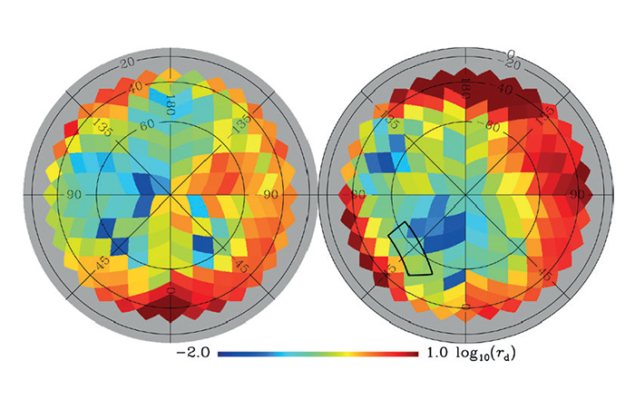
Image credit: Planck Collaboration.
The Planck collaboration has published an all-sky map of the polarized thermal emission of dust grains in the Milky Way. It shows that the field used by the experiment for Background Imaging of Cosmic Extragalactic Polarization (BICEP2) to measure B-mode polarization of the cosmic microwave background (CMB) is contaminated significantly by galactic-dust emission. The B-mode signal detected by the BICEP2 collaboration would, therefore, at least in part, be due to dust, and not to the claimed primordial gravitational waves giving evidence for inflation (CERN Courier May 2014 p13).
The announcement on 17 March 2014 of the detection of swirling B-mode polarization in the CMB by the BICEP2 collaboration took the scientific community by surprise. This particular type of polarization is not spectacular by itself, but by the interpretation that it is due to primordial space–time metric fluctuations “frozen-in” by inflation and then amplified to degree-scale gravitational waves. The BICEP2 results were therefore seen as evidence for inflation, and for a quantum-gravitational process at an energy approaching the Planck scale, where all of the fundamental forces are thought to be unified.
Soon after the initial excitement about this extraordinary result, suspicion arose on the interpretation of the observations in view of possible foreground contaminations. A prime concern was the production of a similar B-mode polarization signal by the thermal emission of asymmetrical dust grains, which align on the magnetic field of the Galaxy (Picture of the month, CERN Courier June 2014 p17). Some researchers incriminated the weak accuracy of dust data used in the BICEP2 study to estimate foreground contamination. New results from ESA’s Planck mission on galactic-dust polarization were therefore highly anticipated.
This paper appeared on the arXiv preprint server on 19 September. Although not yet peer reviewed, the study casts doubts on the interpretation of the B-mode signal being due to primordial gravitational waves. It shows that the amount of dust in the field observed by BICEP2 is significantly higher than was assumed in the paper by the scientists of the Harvard-Smithsonian Center for Astrophysics. How much of the measured B-mode signal is due to dust emission is not yet clear, owing to large uncertainties. The dust contribution extrapolated from the Planck 353 GHz band is, however, found to be at roughly the same level as the observed BICEP2 signal at 150 GHz.
To establish better whether the entire alleged cosmological signal is due to dust foreground, a more detailed analysis of both the BICEP2 and Planck data is currently being carried out jointly by the two teams. The Planck collaboration expects the results of this cross-correlation of the two maps to be published in the same time frame as the next release of Planck data, and results are foreseen for the end of November 2014.
Even if it turns out that the published BICEP2 signal is due to dust solely, this is not the end of the story. Indeed, Planck has shown that there are other regions in the sky with less dust emission. These would be prime targets to observe primordial B-modes by the next-generation instrument, BICEP3, which will soon improve in sensitivity and operate at a frequency of 100 GHz, which is less affected by dust contamination.








